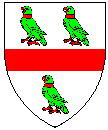
Back to the Glossary
Birds are a common sight in heraldry, particularly eagles, which are shown in a rather stylised fashion, and martlets (a sort of stylised swallow or martin without feet). Other birds tend to be rather more realistically drawn, for instance the popinjays or parrots seen in the Thweng arms: Argent a fess gules between three popinjays vert [according to Burke’s Armory they should be “...collared and membered gules”]
Birds of prey such as eagles and falcons are said to be armed, i.e. with beaks and claws of a particular colour, e.g. Bailey: Vert an eagle displayed argent, armed or
Other birds are said to be beaked and legged or membered.
Hawks and/or falcons are also common; the two are not usually distinguishable. In the middle ages falconry was a very popular pastime, and the falcons seen in heraldry are usually therefore belled and jessed, i.e. with bells on their legs, linked by a leather thong or jess. They are also frequently shown hooded.
Owls are always shown full-face, and almost always close or standing with folded wings.
There are many other birds to be found in heraldry, some drawn considerably closer to life than others. Crows (or rooks or ravens, it is hard to tell) are common. Cocks occur too, and are said to be wattled of a particular colour, usually gules. One also finds ducks, doves, cranes or storks, ...
Particular mention should be made of the peacock, which is usually shown in his pride, that is affronté and with his tail displayed, and the pelican, which bears little resemblance to the real bird, being shown with a somewhat eagle-like body and a stork-like beak. Pelicans are shown vulning themselves, pecking at the breast to draw drops of blood on which they were thought to feed their young! The phoenix is shown as an eagle-like bird rising from the flames of a fire.
Birds can be found in a variety of different positions. There is a specialised vocabulary to describe these, mostly derived from mediaeval or Norman French.
Back to the Glossary Contents.
© Gill Smith 1997, 1998